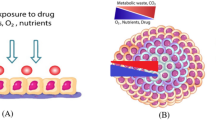Abstract
Purpose
The purpose of this study was to test the susceptibility of human hepatoblastoma and neuroblastoma cells to photodynamic diagnostics (PDD) and photodynamic therapy (PDT) using 5-aminolevulinic acid (5-ALA) as a photosensitizer.
Methods
Cell cultures of human hepatoblastoma (HuH6) and neuroblastoma (MHH-NB-11) were incubated with 5-ALA at increasing concentrations to measure the cellular kinetics of photosensitization. After optimizing incubation parameters, the cell cultures were then irradiated with increasing light doses and cell viability was measured by CTB assay. Human fibroblastic cells served as controls. So far, only the hepatoblastoma cell line has been tested in vivo. After injection of HUH6 cells in immunoincompetent rats, the efficacy of PDT was assessed. Photosensitization was achieved by intraperitoneal injection of 5-ALA. The pharmacokinetics of different tissues was studied. In a second study, a PDT of implanted hepatoblastoma, liver and peritoneum was performed. The irradiated areas were excised 48 h after treatment and studied by microscopy.
Results
Cell culture experiments demonstrated a selective fluorescence for both tumor lines compared to controls. The photosensitized tumor cells demonstrated marked reductions in cell viability at significantly lower irradiation doses than the fibroblasts under PDT. The specificity of fluorescence was confirmed in vivo for hepatoblastoma, and all the sensitized and irradiated tumors showed marked phototoxic necrosis.
Conclusion
Human hepatoblastoma and neuroblastoma demonstrate marked and specific fluorescence after the application of 5-ALA, making PDD possible. Cell death occurred in both cell lines after PDT in vitro. Additionally, hepatoblastoma was susceptible to PDT in an animal model. Further studies will be necessary to determine the role of PDT and PDD in a clinical setting.



Similar content being viewed by others
References
Ackroyd R, Kelty C et al (2001) The history of photodetection and photodynamic therapy. Photochem Photobiol 74(5):656–669
Zaak D, Karl A et al (2005) Diagnosis of urothelial carcinoma of the bladder using fluorescence endoscopy. BJU Int 96(2):217–222
Morton CA, Brown SB et al (2002) Guidelines for topical photodynamic therapy: report of a workshop of the British Photodermatology Group. Br J Dermatol 146(4):552–567
Stummer W, Pichlmeier U et al (2006) Fluorescence-guided surgery with 5-aminolevulinic acid for resection of malignant glioma: a randomised controlled multicentre phase III trial. Lancet Oncol 7(5):392–401
Till H, Bergmann F et al (2005) Videoscopic fluorescence diagnosis of peritoneal and thoracic metastases from human hepatoblastoma in nude rats. Surg Endosc 19(11):1483–1486
Doi I (1976) Establishment of a cell line and its clonal sublines from a patient with hepatoblastoma. Gann 67(1):1–10
Pietsch T, Gottert E et al (1988) Characterization of a continuous cell line (MHH-NB-11) derived from advanced neuroblastoma. Anticancer Res 8(6):1329–1333
Acknowledgments
We acknowledge the help of Michael Heide. This work was supported by a grant from the Deutsche Forschungsgemeinschaft (TI 609/1-1 2006). Equipment and materials were partially sponsored by Karl STORZ and Medac.
Author information
Authors and Affiliations
Corresponding author
Rights and permissions
About this article
Cite this article
Bergmann, F., Stepp, H., Metzger, R. et al. In vitro and in vivo evaluation of photodynamic techniques for the experimental treatment of human hepatoblastoma and neuroblastoma: preliminary results. Pediatr Surg Int 24, 1331–1333 (2008). https://doi.org/10.1007/s00383-008-2275-9
Published:
Issue Date:
DOI: https://doi.org/10.1007/s00383-008-2275-9




